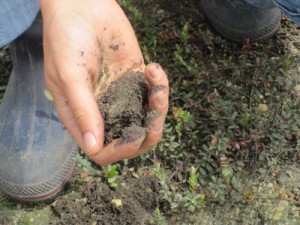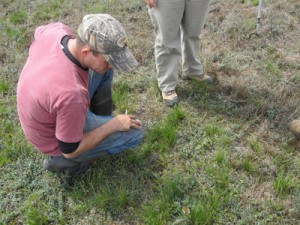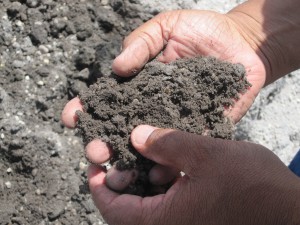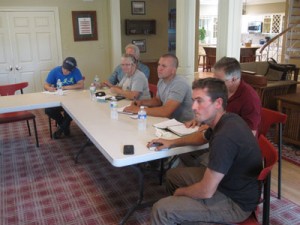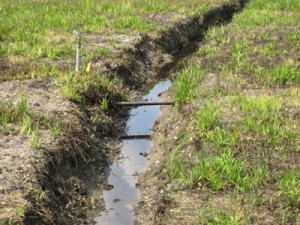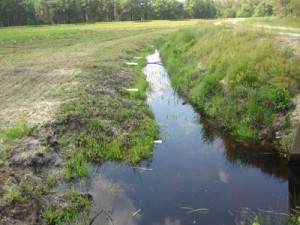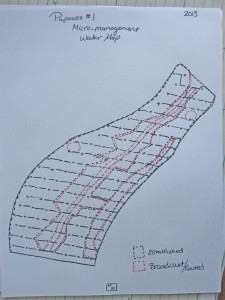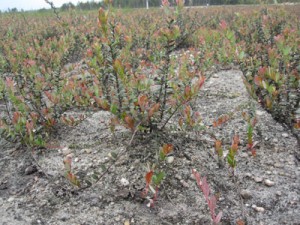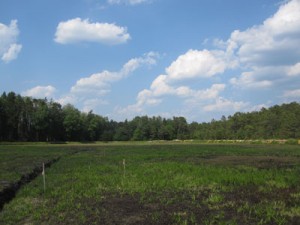If you’ve been paying attention over the past year, you’ll know that one of Pine Island’s core values is continuous improvement: doing everything we do better every day. Over the past few weeks, we’ve been taking you through our efforts at improving drainage, and part of that is making sure that the soil in our newer beds is doing what it’s supposed to do.
According to the UMass Cranberry Station: “Cranberry bog soil is unique in that it consists of alternating layers of sand and organic matter. Dead leaves accumulate over the course of time and sand is added to the bed surface every 2-5 years to encourage upright production and maintain productivity. In contrast to normal agricultural soils, cranberry soil requires no tilling, remains undisturbed over time, and little mixing of sand and organic matter occurs.”
However, with our Sim Place bogs, we’ve had to become, in Bill’s words, “bog doctors”: adding ditches, installing more underdrain, repairing existing underdrain, and replanting weak areas. “It’s making it better,” he says. “But we’re not where we should be.” While it’s not an ideal situation, “[t]he bogs at Sim Place weren’t very productive when we started. Anything they’ve been producing is a bonus. But we need to make a plan. What’s been working for us on the home farm is not going to work out there, because the soil isn’t uniform. We need to figure out what we have, and get ahead of it.”
This week, Bill sat down with GM Fred Torres, PIICM manager Cristina Tassone, team members Jeremy Fenstermaker and Matt Giberson, Dan Schiffhauer of Ocean Spray, Peter Oudemans of Rutgers University, and Joan Davenport of Washington State University in order to weigh some options and work on a plan for the next round of renovations.
The bogs at Sim Place have been of mixed construction, and the same methods that we’ve used at the home farm haven’t always worked out there. Papoose #1 has had several issues with drainage, partly due to the type of soil we added on top. You can see where our team has tried several different drainage improvement methods, such as underdrain at varying depths and adding a ditch just last fall.
We have been able to get this bog to dry out, but now we have to micromanage different growth stages of the plants we used to get the bog to fill in. Just as we do in Fishhead #1, we have established areas and rooted cuttings in addition to pressed-in vines. This map shows the different planting areas so when we irrigate, anyone will know where to let sprinklers run and where to shut them off.
Getting back to our discussion with the experts: the key to renovation is soil testing, which is required for optimum yield and quality of berries. The question here is: how deep will we need to go for a core sample, and how many samples should we take? Bill, concerned with layers for adequate drainage, commented that as long as we have two feet of sand plus the topsoil layer, what’s underneath doesn’t really matter. Joan, Dan, and Peter all agreed that it allowed for ideal underdrain installation as well as capillary rise (rise of water into the root zone).
Since consistent uniform texture is what’s needed, we will need to acquire the proper equipment, although we will be able to test the soil ourselves, Joan says. And fortunately, “even with gravel in some of these soils, they are so much easier to probe into than regular mineral soils,” she adds. “And should you run into clay, it’s wet enough that you won’t damage your equipment.” While this is not an issue on the home farm, Sim Place has a lot more variability, and in addition to drainage issues, the soil needs to be able to take the essential nutrients to help both new and established beds.
The end result of the discussion: we will need to make a 50′ x 50′ grid and take the soil samples. Once we determine precisely what soil layers we have, we draw up a plan and decide how we make the bed uniform in order to make the best decisions regarding irrigation as well as water filtration. The more efficient we become with our renovation process, the better our production.

